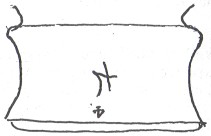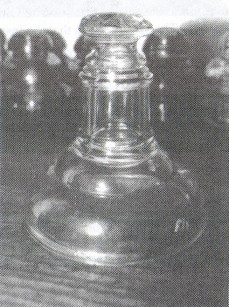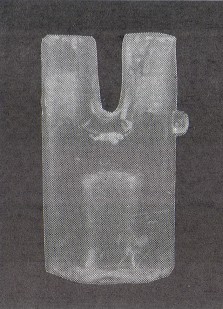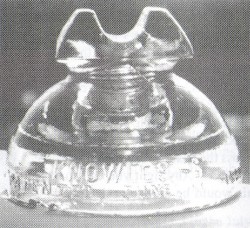MAC's Believe It Or Not!
by John McDougald
Reprinted from "Crown Jewels of the Wire", October 1994, page 10
"Can't wait 'til Mac is a monthly column. This should not be difficult to accomplish with all the recent activity and new
finds. After all, the foreign and porcelain insulator collectors look forward to
their monthly columns, right? It's time we, the depressed North American glass
collectors, stand up and demands our rights! Bring on Mac!"
This should not be difficult to accomplish with all the recent activity and new
finds. After all, the foreign and porcelain insulator collectors look forward to
their monthly columns, right? It's time we, the depressed North American glass
collectors, stand up and demands our rights! Bring on Mac!"
Okay! Okay! This recent letter told me that I had better get pen in hand
again on a regular basis. Truth of the matter is that I am in the last six weeks
of preparation to sit for the Certified Public Accountant's exam and that I have
been in review classes for six months, as well as a full time graduate student
working on a Masters in Accountancy/Taxation and teaching two sections of
sophomore Financial Accounting at Northern Illinois University. Enough of my
commitments...on to Believe It Or Not!
Robert Winkler of Michigan City, Indiana writes.....Well, you said in the July
issue to send news to Mac. I have a CD 131 Brookfield, light bubbly blue aqua.
It is marked: CAUVETS PAT JULY 25 1865 on the dome in big crude letters. On the
skirt below; W. BROOKFIELD, 55 FULTON St N.Y., in small serifed letters. It has
what looks like a large upside down 4 on the back of the skirt. What's
interesting to me is the small serifed letters JULY 25 1865 just on top (above
the
big letters) as shown below:

This proves a version with small print dome embossing existed prior to the
big crude lettering which is so common. What I recently noticed was also
interesting. Just below the big "carved" number 4 on the back is a
little serifed 4! A neat piece, all the way around!

* * * * * * * * * * * *
Thanks for writing, Robert. I know you've always been interested in the old
Brookfields and the sequential progress of embossings. The small embossing on
the skirt of the CD 131 has always seemed a little peculiar. I certainly would like to hear from any reader who has a CD 131 with only the
small embossing. That would go nicely with Robert's piece.
Now here is a real "Believe It Or Not!" from John
Badowski,
Grimsby, Ontario, Canada....
I recently picked up a collection which has been in storage for some 20
years. One piece remains a riddle to me and I have shown it to a half dozen
other collectors who also state that they can't identify it either.
I was hoping
you could tell me what it was, or perhaps ask your readers to help me out. It is
clear glass, unthreaded, smooth base. It has no markings at all and measures
5.5" across the base, and approximately 6" in height. Any light you
can shed on this would be a great assistance!

* * * * * * * * * * *
At this point I could only tell you that it doesn't appear to be an
insulator, at least not in the standard sense. I'm reminded of a piece that
surfaced five to six years ago from Jamaica and looked like an overgrown
Bordeaux. (Look that one up in your history files! Ans: ((upside-down)See CJ.
Mar. '87, p.2) Anyway, one of our readers came up with a possible suggestion as to its use.
Maybe a couple thousand more pairs of eyes will have some answer for this one
too. Thanks, for writing, John!

This may be a record, but this piece has been pictured in three CJ issues
this year. But new information keeps coming to the surface, so here it is one
more time. Russ Sprague of Pasadena, Maryland shares the following:
Here is late breaking news regarding the clear slash top that was in an
article in July and again in September. It has now been assigned a CD number, CD
787. And thanks to Ray Klingensmith, some information regarding its use and time
period. Ray dug through his vast library of insulator-telegraph information and
came up with some more facts.
He found a drawing matching my slash top and an article stating that it was
used on a line of the Atlantic and Ohio Telegraph Company operating in the 1850'
s. The article states that the insulator was of "fine quality glass, but of
a very poor design."
Thanks, once again, for Ray's information. We of the
insulator hobby are indebted to Ray for his many contributions to the hobby. Ray
says that he may have a follow up story later.
And from Barry Conolly of Westford, Vermont, I received the following:
This
summer I picked up a KNOWLES CD 292.5 insulator at a nearby antique store. It
has some damage but the glass is bright and shiny and it has a good shade of
blue. Not knowing the price guide value of the insulator at the time, I balanced
the $30.00 cost and the skirt chips, against the fact that I did not have this
CD in my collection. Finally, I paid the $30.00 and brought it home, washed it
up and put it on the shelf. Now I'm really glad I did.
Looking the insulator up
in your Volume 2 reference book, I was surprised to find the insulator's
embossing not listed. It is closest to your third entry, (F-Skirt) [Prism]/
"KNOWLES-6" / "PATENTED. JUNE.17.1890" (R-Skirt) BOSTON. It
has a smooth base. Mine is identical except it does not have the Prism. As you
can see from the photographs the embossing is well defined and I can tell you
there is definitely not even a hint of the Prism above the
"KNOWLES-6". Should I consider this an intentionally undocumented
embossing variant? Or does the lack of the Prism warrant more consideration.


Thanks for the new listing, Barry. It will be included in the new price guide
coming out this winter. As to the reason behind the missing Prism, I don't think
we'll ever know what was going through the minds of the mold engravers, or what
instructions caused them to do what they did. Part of the ongoing fascination of
embossing variations.
| 